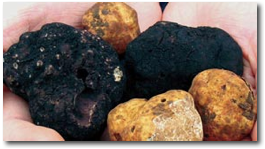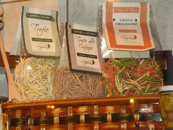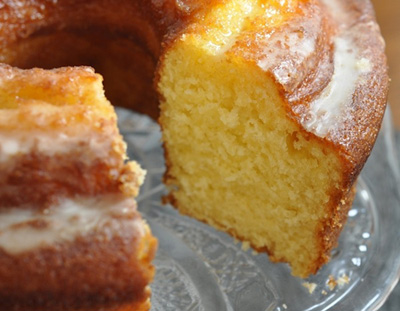Ci scusiamo. Al momento non è disponibile alcuna traduzione italiana per questa pagina.
Truffle Crazy
By Helen Donegan
http://www.italywithus.com/index.php
 Truffles are the things, I think, that illustrate more than most how much Italians love their food. I had never really heard of them before I came to live in Italy. Then I only ate them when some one else was paying.
Truffles are the things, I think, that illustrate more than most how much Italians love their food. I had never really heard of them before I came to live in Italy. Then I only ate them when some one else was paying.
One day ten years ago my husband came home with enough “truffle” to do two plates of pasta (a very tiny piece). He was all pleased with himself and had paid $40 – I nearly throttled him! I couldn’t believe someone would pay so much for a plate of pasta! Now I know better – people go crazy for them! So I would just like to take you through a fact-finding tour and let you know of the various truffles festivals that are held in Italy during the Autumn/Winter.
The first thing is of course to explain what truffles are; I can’t be the only person who didn’t know! Basically truffles are glorified mushrooms (I am sorry, I am sorry!) that are found in certain areas in Italy (and some other countries). There are many different types, but we can divide them into white & black and then again by season.
The big divide between white and black truffles causes endless discussion here – the white truffle mainly comes from the North of Italy, especially in the Piemonte region. These are considered superior by about 75% of the experts; some even claim they have aphrodisiacal qualities!
“True truffles” have to come from certain areas and be grown in the right season – the black winter truffle is found mainly in Umbria from mid-November until mid-March. The black truffles are favored by the other 25% of the above-mentioned “experts.” The white truffle is officially found in the Piedmont region of Italy from early October through late December but they can come from other areas of the North of Italy. There are other “inferior” truffles, including the summer truffles.
Attempts to produce truffles commercially have all failed; they will not grow “on demand.” They grow underground, mainly at the roots of oak trees – but also chestnut, hazel, or beech trees at times. Specially trained pigs or dogs sniff them out, and it is this long slow process, which makes them so expensive. The men who collect the truffles are highly expert in their work. They are said to be able to identify the shape of a tree, which will have good truffles under the roots. If the truffle isn’t ready for eating, it will be put back under the soil to be harvested later. Searching for truffles is almost religious in a way. The men and their animals are greatly revered by many. I found the many accounts which demonstrate a little of the “magic” involved in the whole process.
With the scarcity of the truffle and the difficulty in finding it in the first place, the price keeps going up. Of course this leads to shady and sometimes criminal activity. Some restaurants will go to incredible lengths to satisfy their clients. This encourages racketeering, etc. You also have to make sure that the restaurant or shop selling them is reliable. Not everything called a truffle is a truffle; there are many “fake” varieties. Personally I can’t tell the difference and, if the price is right, I don’t care! (I know that is sacrilege to all “foodies”).
There are lots of recipes using truffles. It depends on the quality of the truffle if you cook them or not. Now a complete industry has grown up around truffles, and there are many types of oils and sauces made with them. Purists say that you can’t preserve truffles – putting them in oil is supposed to ruin the truffle and the oil. They say you should eat them fresh, within two weeks of being taken from the ground. Apparently the taste diminishes even within these two weeks, so the fresher the better. However I think, if you like the taste of truffles and have no alternative, you will enjoy the various products with a truffle flavor. (See recipe for Spaghetti with Black Truffles on the next page.)
There are lots of special events held throughout the year where you can taste truffles and enjoy the party-type atmosphere they evoke. If you are going to be in Italy during truffle season, try phoning the hotlines below to learn of local truffle festivals:
| Truffle Festival Hotlines |
| Alba: 0173/362-807 |
Mondovì: 0174/559-263, 559-256 |
| Asti: 0141/399-482, 399-399 |
Montechiaro d’Asti: 0141/999-136 |
| Canelli: 0141/823-685, 820-111 |
Murisengo: 0141/993-041 |
| Moncalvo: 0141/917-505 |
|



 Truffles are the things, I think, that illustrate more than most how much Italians love their food. I had never really heard of them before I came to live in Italy. Then I only ate them when some one else was paying.
Truffles are the things, I think, that illustrate more than most how much Italians love their food. I had never really heard of them before I came to live in Italy. Then I only ate them when some one else was paying.

 Mix flour and salt in a large bowl. Make a well in the center and pour in the water. Start mixing the ingredients until all the flour is incorporated and the dough looks cohesive. (If the dough is too sticky, add a bit more flour).
Mix flour and salt in a large bowl. Make a well in the center and pour in the water. Start mixing the ingredients until all the flour is incorporated and the dough looks cohesive. (If the dough is too sticky, add a bit more flour). A handmade pasta shaped like a string bean, you can find trofie all along the Italian Riviera restaurant menus and in Ligurians’ homes. The traditional name trofie possibly derives from “strafuggià” (to rub), the movement done with one’s hands to make this kind of pasta.
A handmade pasta shaped like a string bean, you can find trofie all along the Italian Riviera restaurant menus and in Ligurians’ homes. The traditional name trofie possibly derives from “strafuggià” (to rub), the movement done with one’s hands to make this kind of pasta.
